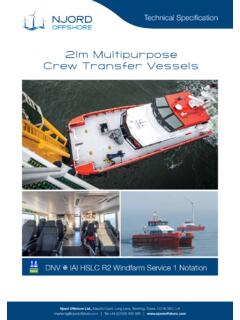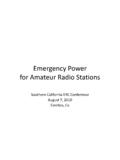Transcription of Study Guide for the Restricted Operator's Certificate
1 RIC-23 Issue 3 March 3, 1997 Spectrum ManagementRadiocommunication Information Circular Study Guide for the RestrictedOperator's CertificateAussi disponible en fran ais ) CIR-23 Radiocommunication Information Circulars are issued for the guidance ofthose engaged in radiocommunications in Canada. The informationcontained in these circulars is subject to change without notice. It istherefore suggested that interested persons consult the nearest districtoffice of Industry Canada for additional details. While every reasonableeffort has been made to ensure accuracy, no warranty is expressed orimplied. As well, these circulars have no status in law. Additional copies ofthis or other circulars in the series are available from any office of and suggestions may be directed to the following address:Industry CanadaRadiocommunications andBroadcasting Regulatory Branch300 Slater StreetOttawa, OntarioK1A 0C8 Attention: DOSPvia e-mail: spectrum publications are now available on the Internet at: of 1 Restricted Operator's 3 Applying to Industry Canada for a Certificate 3 Knowledge Required for the 3 Radio Station Licences.
2 4 Communications - 5 Superfluous Communications and 5 Unnecessary 5 Profane and Obscene 5 False Distress 5 Secrecy of 6 Communications 6 Channel/Frequency 6 International Distress, Calling and Answering 7 Radio 7 VHF Radiotelephone 9 Intership 9 Public Correspondence 9 Vessel Traffic Services 9 Broadcast 9 Emergency 9 Operating Procedures - 10 Microphone 10 Procedural Words and 10 Phonetic 15 Table of 17 Single Station 17 Reverse 18 General 18 Multiple Station 18 Coast Station Traffic 19 Replying to Calls when Information Is 20 Termination of 20 Components of a 20 Corrections and 21 Corrections and Repetitions during 21 Repetitions after 22 Control of 23 Unsuccessful 23 Signal 24 Readability 25 Distress 25 Frequencies to Be 26 Control of Distress 26 Distress 26 Distress 26 Distress 27 Distress 27 Repetition of a Distress 28 Action by Station in 29 Action by Stations Other than the Station in 29 Acknowledgement of Receipt of a Distress 29 Action by Station Acknowledging Receipt
3 Of a Distress 30 Action by Other Stations Hearing a Distress 30 Distress 30 Relay of a Distress 31 Imposition of 32 Cancellation of 32 Urgency 34 Urgency 34 Table of ContentsiiiUrgency 35 Cancellation of Urgency 36 Safety 37 Safety 37 Safety Call and Message 37 The Global Maritime Distress and Safety 40 Figure 1 - GMDSS 40 Emergency Position Indicating Radio Beacons (EPIRBs).. 41 Equipment Fundamentals and General Electronic 43 Radiotelephone Transceiver 43 Channel 43On/Off and Volume 43 Squelch 43 VHF - Power 44 Repair and Maintenance 44 Lead Acid Storage 45 Charging and Discharging Storage 47 List of Industry Canada District Office Locations by 47 Study Guide for the Restricted Operator's CertificateRIC-231 IntroductionThe material presented in this publication covers the scope of the Restricted operator 'sCertificate examination. This publication will also be required by candidates wishing to obtain theGeneral Operator's is a member of the International Telecommunication Union (ITU), an organizationestablished to regulate the spectrum, providing basic standards for communication procedures andpractices, frequency allocation and radio regulations on a worldwide basis.
4 The ITU sets theminimum standards that candidates should meet for obtaining the various classes of radiooperator's is also a member of the International Maritime Organization (IMO), which isresponsible for marine equipment and operations, especially concerning safety at Canada administers telecommunications in Canada, based on both national andinternational acts, regulations and conventions. Marine operations in Canada are generallyregulated by the Canadian Coast Guard of the Department of bring the Canadian Certificate in line with changes in the international requirements,Industry Canada, in collaboration with the Coast Guard, has established five (5) marinecertificates. Two certificates are reserved for Coast Guard radio operators. The remaining threeradio Operator's certificates are listed below:1. Restricted Operator's Certificate ,2. General Operator's Certificate , and 3. Radiocommunications General Maritime Coast Guard (Ship Manning Regulations) requires ships that are compulsorily fitted withradio equipment to carry persons who hold the appropriate Certificate for the type of voyage andthe equipment speaking, ships fitted with VHF radiotelephones must carry persons who hold aRestricted Operator's Certificate , and ships that are fitted with MF or MF/HF radiotelephones, orship earth stations, must carry persons who hold either a General Operator's Certificate or aRadiocommunications General Maritime Certificate .
5 There are two exceptions to first exception is for the radio operators on small fishing vessels . (A small fishing vesselis described as a vessel that is used in commercial fishing, and that does not exceed 24 meters inlength and does not exceed 150 tons, gross tonnage.) This exception permits such vessels fittedwith MF or HF transmitting equipment, or both, to carry radio operators holding only aRestricted Operator's Certificate . Study Guide for the Restricted Operator's CertificateRIC-232 The second exception is for radio operators on vessels using the Athabasca-Mackenzie inlandwaterways. Even though HF radios may be carried by vessels on this waterway, the HF frequencyused is outside of the marine bands. The only marine frequencies used in certain areas of thiswaterway are in the VHF band. Consequently, operators on these vessels are only required tohold a Restricted Operator's publications that will be of assistance to candidates taking the government examinationsare the Radio Aids to Marine Navigation (RAMN) and, to a lesser extent, the Ship Station RadioRegulations (SSR) and the Ship Station Technical Regulations (SST).
6 These last two documentshave been established in accordance with the Canada Shipping Act (CSA).The Global Maritime Distress and Safety System (GMDSS) is being implemented over aseven-year period, commencing February 1, 1992 and finishing on February 1, 1999. Thisworldwide system will enhance the assistance that can be given to ships in distress and urgencysituations. Certificate requirements and background on the area concept of the GMDSS can befound in Radiocommunication Information Circular 16 (RIC-16), Professional Radio operator 'sCertificate. For additional information on this system, also refer to the present publication underthe headings "Distress Communications", "Urgency Communications" and "SafetyCommunications". Current information on the progress and availability of this system will beavailable in the latest editions of the Radio Aids to Marine Navigation and the annual edition ofNotices to Information Circulars are available at your local district office ofIndustry Canada.
7 Other publications, such as the Radio Aids to Marine Navigation and the annualedition of Notices to Mariners are available from booksellers offering government documents andpublications, or by mail from:Communications Group - Publishing Ottawa, OntarioK1A 0S9 Inquiries concerning the contents of this publication, or suggestions for its improvement maybe directed to: Industry CanadaRadiocommunications andBroadcasting Regulatory Branch300 Slater StreetOttawa, OntarioK1A 0C8 Attention: DOSP-A Study Guide for the Restricted Operator's CertificateRIC-233 Restricted Operator's CertificateGeneralA Restricted Operator's Certificate (ROC) or higher grade Certificate is required by theoperator of a VHF radiotelephone equipped vessel. The radiotelephone equipment at suchstations shall be of a type that requires only simple external switching, and allfrequency-determining elements must be preset within the for the ROC examination do not have to be Canadian citizens or landedimmigrants.
8 The candidates must, however, be able to identify themselves. A birth Certificate , abaptismal Certificate , a citizenship Certificate , a passport or a driver's licence may be used to do is no age limit for a person writing the Certificate examination. Restricted operator 'sCertificates are issued for life. No further validation is required. If a Certificate is lost or requiresreplacement, the nearest district office of Industry Canada should be to Industry Canada for a Certificate ExaminationApplication to be examined for the Restricted Operator's Certificate (ROC) should be made tothe nearest district office of Industry completing an application for a Restricted Operator's Certificate , candidates may berequested to certify that they have no physical disabilities that would impair their ability to safelyoperate a radio may be held at departmental district offices or at locations suitable forexamination purposes. The telephone number for the district office in your area is listed in thelocal telephone directory.
9 (The names of the district offices are listed in the Appendix of thisdocument.)Knowledge Required for the ExaminationThe candidates will be required to satisfy an examiner that they:1. are capable of operating modern VHF radiotelephone equipment,2. possess a general knowledge of radiotelephone operating procedures, internationalregulations applicable to radiotelephone communications between stations, as well asthose specific regulations relating to safety of life, and3. possess practical knowledge of the operation of Global Maritime Distress and SafetySystem equipment for vessels engaged on voyages within the range of VHF coast Guide for the Restricted Operator's CertificateRIC-234 Radio Station Licences Unless exempted all radio stations in Canada must be licensed by the Minister. The licence (orcopy thereof) must be posted in a conspicuous place near the radio radio station licence generally specifies the call sign assigned to the station, thefrequencies to be used for transmitting, the type of radio equipment authorized, and any specialconditions under which the station should be obtain a radio station licence, a completed licence application form with the prescribed feeshould be submitted to Industry Canada.
10 The application is then processed, and a licence isforwarded to the licensee. (Station licence application forms are available from any IndustryCanada district office.)To be eligible for licensing in Canada, radiotelephone equipment must be type approved ortechnically acceptable for licensing by the Department. Industry Canada type approval number isa nine-digit number appearing on a label affixed to the radio (usually at the back of the set) andassures the purchaser or owner of the radio equipment that it meets Canadian technical , before purchasing a radiotelephone, one must ensure that it is labelled with theIndustry Canada type approval number or that it has been granted technical acceptability byIndustry licence fees are due on April 1 of each year. Billing notices are mailed to licenseesdirectly from departmental headquarters in :Any person who establishes a radio station without the benefit of a radio licence is liable,on summary conviction, to a penalty of up to five thousand dollars ($5,000), or toimprisonment for a term not exceeding one year, or both or, in the case of a corporation,to a fine not exceeding twenty-five thousand dollars ($25,000).





